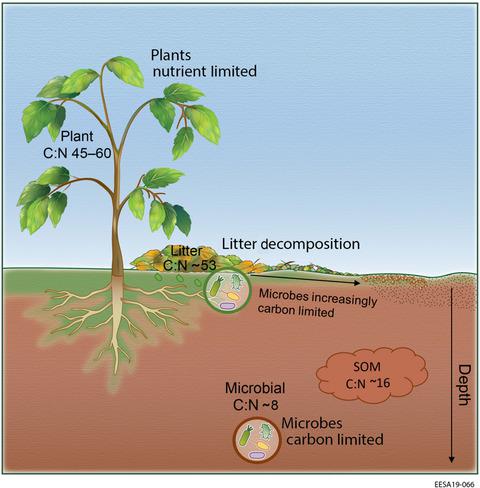当前位置:
X-MOL 学术
›
Glob. Change Biol.
›
论文详情
Our official English website, www.x-mol.net, welcomes your
feedback! (Note: you will need to create a separate account there.)
Microbial carbon limitation: The need for integrating microorganisms into our understanding of ecosystem carbon cycling.
Global Change Biology ( IF 10.8 ) Pub Date : 2019-12-14 , DOI: 10.1111/gcb.14962 Jennifer L Soong 1 , Lucia Fuchslueger 2, 3 , Sara Marañon-Jimenez 4, 5 , Margaret S Torn 1 , Ivan A Janssens 2 , Josep Penuelas 4, 5 , Andreas Richter 3, 6
Global Change Biology ( IF 10.8 ) Pub Date : 2019-12-14 , DOI: 10.1111/gcb.14962 Jennifer L Soong 1 , Lucia Fuchslueger 2, 3 , Sara Marañon-Jimenez 4, 5 , Margaret S Torn 1 , Ivan A Janssens 2 , Josep Penuelas 4, 5 , Andreas Richter 3, 6
Affiliation

|
Numerous studies have demonstrated that fertilization with nutrients such as nitrogen, phosphorus, and potassium increases plant productivity in both natural and managed ecosystems, demonstrating that primary productivity is nutrient limited in most terrestrial ecosystems. In contrast, it has been demonstrated that heterotrophic microbial communities in soil are primarily limited by organic carbon or energy. While this concept of contrasting limitations, that is, microbial carbon and plant nutrient limitation, is based on strong evidence that we review in this paper, it is often ignored in discussions of ecosystem response to global environment changes. The plant-centric perspective has equated plant nutrient limitations with those of whole ecosystems, thereby ignoring the important role of the heterotrophs responsible for soil decomposition in driving ecosystem carbon storage. To truly integrate carbon and nutrient cycles in ecosystem science, we must account for the fact that while plant productivity may be nutrient limited, the secondary productivity by heterotrophic communities is inherently carbon limited. Ecosystem carbon cycling integrates the independent physiological responses of its individual components, as well as tightly coupled exchanges between autotrophs and heterotrophs. To the extent that the interacting autotrophic and heterotrophic processes are controlled by organisms that are limited by nutrient versus carbon accessibility, respectively, we propose that ecosystems by definition cannot be 'limited' by nutrients or carbon alone. Here, we outline how models aimed at predicting non-steady state ecosystem responses over time can benefit from dissecting ecosystems into the organismal components and their inherent limitations to better represent plant-microbe interactions in coupled carbon and nutrient models.
中文翻译:

微生物碳限制:需要将微生物纳入我们对生态系统碳循环的理解。
大量研究表明,使用氮、磷和钾等营养素施肥可提高自然生态系统和管理生态系统中的植物生产力,表明大多数陆地生态系统的初级生产力受营养限制。相反,已经证明土壤中的异养微生物群落主要受有机碳或能量的限制。虽然这种对比限制的概念,即微生物碳和植物养分限制,是基于我们在本文中回顾的有力证据,但在讨论生态系统对全球环境变化的反应时,它往往被忽视。以植物为中心的观点将植物养分限制等同于整个生态系统,从而忽略了负责土壤分解的异养生物在驱动生态系统碳储存中的重要作用。要在生态系统科学中真正整合碳和养分循环,我们必须考虑到这样一个事实,即虽然植物生产力可能受养分限制,但异养群落的次级生产力本质上是受碳限制的。生态系统碳循环整合了其各个组成部分的独立生理反应,以及自养生物和异养生物之间的紧密耦合交换。就相互作用的自养和异养过程分别受营养物质和碳可及性限制的生物体控制而言,我们建议根据定义,生态系统不能仅受营养物质或碳的“限制”。这里,
更新日期:2020-01-26
中文翻译:

微生物碳限制:需要将微生物纳入我们对生态系统碳循环的理解。
大量研究表明,使用氮、磷和钾等营养素施肥可提高自然生态系统和管理生态系统中的植物生产力,表明大多数陆地生态系统的初级生产力受营养限制。相反,已经证明土壤中的异养微生物群落主要受有机碳或能量的限制。虽然这种对比限制的概念,即微生物碳和植物养分限制,是基于我们在本文中回顾的有力证据,但在讨论生态系统对全球环境变化的反应时,它往往被忽视。以植物为中心的观点将植物养分限制等同于整个生态系统,从而忽略了负责土壤分解的异养生物在驱动生态系统碳储存中的重要作用。要在生态系统科学中真正整合碳和养分循环,我们必须考虑到这样一个事实,即虽然植物生产力可能受养分限制,但异养群落的次级生产力本质上是受碳限制的。生态系统碳循环整合了其各个组成部分的独立生理反应,以及自养生物和异养生物之间的紧密耦合交换。就相互作用的自养和异养过程分别受营养物质和碳可及性限制的生物体控制而言,我们建议根据定义,生态系统不能仅受营养物质或碳的“限制”。这里,











































 京公网安备 11010802027423号
京公网安备 11010802027423号